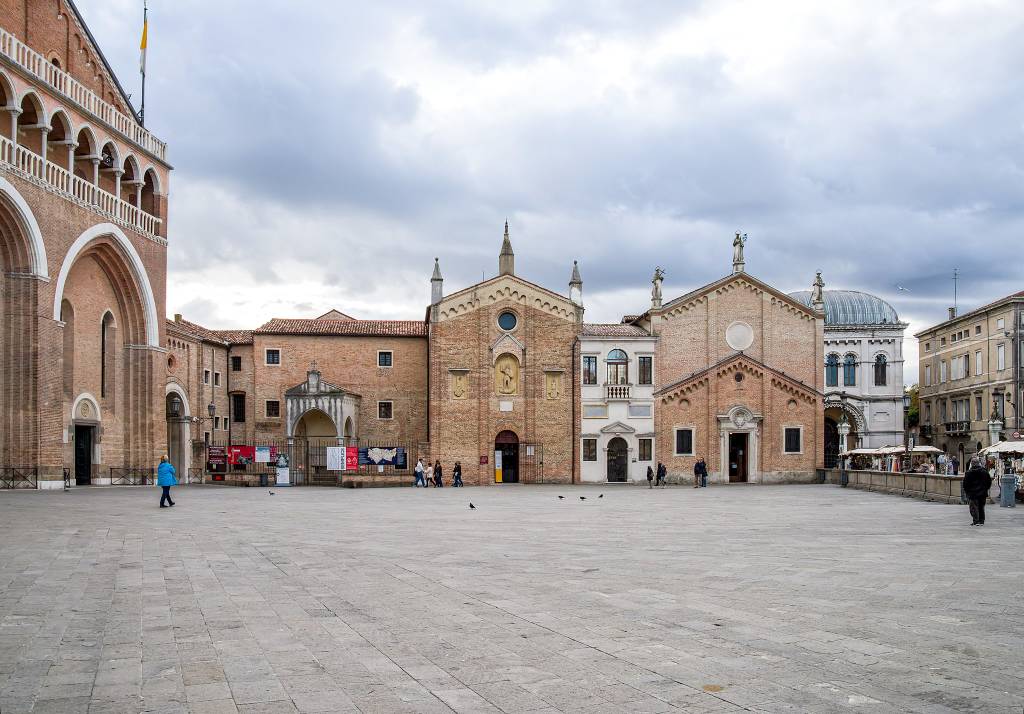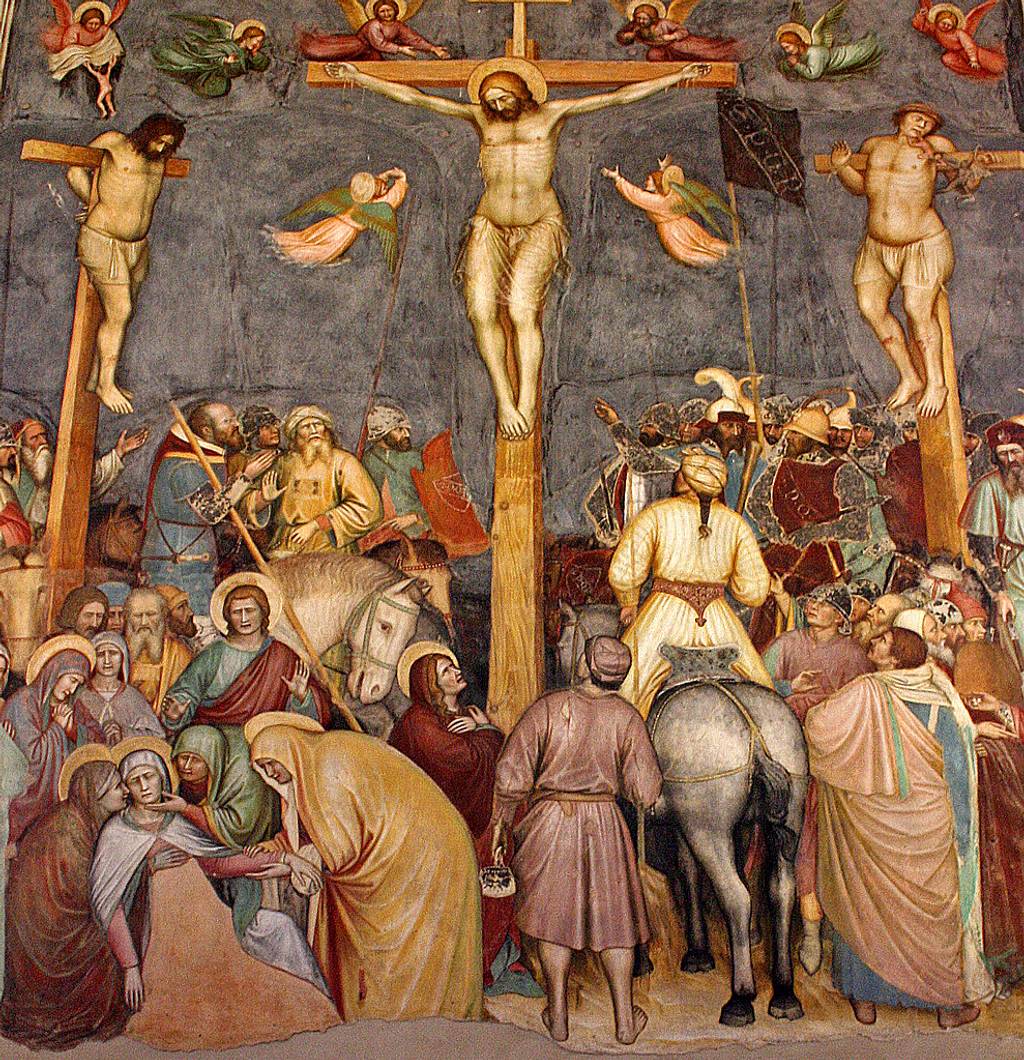Oratory of St. George Piazza del Santo, Padua (PD), Veneto, Italy
Oratory of Saint George
An aristocratic family mausoleum decorated by Altichiero da Zevio with frescoes depicting scenes from the Life of Christ and of Saint George

Overlooking the churchyard of the Basilica del Santo stands the Oratory of San Giorgio, a family mausoleum built in 1277 by Raimondino Lupi di Soragna, a member of a family with very close links to the Carrarese court, to house the mortal remains of Bonifacio Lupi di Soragna. It was built seventy years later than Cappella degli Scrovegni, but its architecture and interior decorations remind of the famous chapel, primarily due to the narrative mode of the frescoes.
The Oratory of Saint George presents a pictorial cycle painted by Altichiero, who completely decorated its interior walls, between 1379 and 1384, with the collaboration of Jacopo da Verona. The artist already has had contact with the family thanks to his work in Saint James Chapel within the Basilica of Saint Anthony. Altichiero's work is not only an honorary reference to Giotto but a study of the work of the other great artist then active in Padua like Giusto de’ Menabuoi, whose marvellous cycle of frescoes in the Cathedral Baptistery will undoubtedly have been known to Altichiero. His paintings exalt the warrior virtues of the Lupi family, befitting the special rank the family had achieved from the mid-fourteenth century onwards thanks to their military and diplomatic services to the lords of the city. The quality of the painting and pictorial space is an innovative masterpiece updated according to the new Gothic style that anticipated the perspective space of the fifteenth century.
Description of the frescoes cycle
Entirely covering the walls of the Oratory, the frescoes are by Altichiero da Zevio working in collaboration with Jacopo da Verona; the latter would also paint the fresco cycle in the Oratory of Saint Michael.
The pictorial cycle has an unavoidable point of reference in Giotto's Scrovegni Chapel, with the images culminating in a starry sky on which portraits of sacred characters stand out. Also, the narrative story is inspired by one of the most popular religious works of the Middle Ages, the Golden Legend by Jacopo da Varazze. Overall, a narrative movement is leftwards from one scene to another, emphasising the temporal sequence.
The iconography is centred on scenes from The Life of Christ, the Crucifixion, the Coronation of the Virgin, and the Lives of the patron saints of the Lupi family ‒ Saint George, Saint Catherine of Alexandria, and Saint Lucy.
The images in the cycle also highlight the martial and courtly virtues that the Lupi family embodied in their service to the Carraresi lords of Padua. The family members are shown in full armour within the frescoes themselves, kneeling before the Madonna, and a painted inscription identifies each. There are other important figures of the time also depicted alongside the dukes of Soragna, one of which is Francesco Petrarca in the scene of The Baptism of King Servius.
At the centre of the oratory stood the complex architectural-sculptural structure of the founder's funeral ark, of which the stone tomb is still preserved. It was said that the tomb complex included ten life-sized statues of de’ Lupi and his family, two of which are still standing today.
The frescoes of the Oratory were completed in 1384. Brought to light in 1837, after they were whitewashed over during the Napoleonic Wars, the frescoes were the subject of an essential restoration between 1995 and 1997.
We welcome all contributions, no matter how small. Even a spelling correction is greatly appreciated.
All submissions are reviewed before being published.
Continue to changelog-

© 'Oratory of St. George' by joergens.mi is licensed under CC BY-SA 4.0 Attribution copied to clipboard Failed copying attribution to clipboard -

© 'Padua' by dvdbramhall is licensed under CC BY-NC-ND 4.0 Attribution copied to clipboard Failed copying attribution to clipboard -

© 'Crucifixion, Altichiero da Zevio' by f_snarfel is licensed under CC BY-NC 4.0 Attribution copied to clipboard Failed copying attribution to clipboard -

We welcome all contributions.
All submissions are reviewed before being published.
We welcome all contributions, no matter how small. Even a spelling correction is greatly appreciated.
All submissions are reviewed before being published.
Continue to changelogWe welcome all contributions, no matter how small. Even a spelling correction is greatly appreciated.
All submissions are reviewed before being published.
Continue to changelogWe welcome all contributions, no matter how small. Even a spelling correction is greatly appreciated.
All submissions are reviewed before being published.
Continue to changelogCategory
Cost
-
One of the most famous and visited sanctuaries in the world and a testament of art decorated by Giotto, Giusto de' Menabuoi, Altichiero da Zevio, and Jacopo Avanzi
-
Once the humble dwelling of Saint Anthony, the Friary developed over the centuries into the five splendid cloisters located on the southern side of the Basilica.
-
99 m
Piazza del Santo is a miniature citadel sheltered by the splendid masterpieces of the Oratory of Saint George and the Gattamelata statue.
-
The oldest Heritage Garden in the world, home to over 6,000 different plant specimens and the futuristic Garden of Biodiversity
-
The Giardino Treves de' Bonfili is one of Padua’s most renowned historical gardens, a hidden jewel of architectural and landscape creation by Giuseppe Jappelli.



